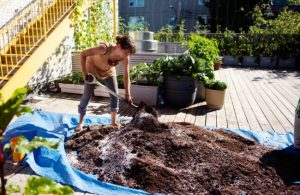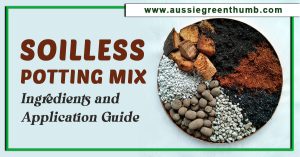Phosphorus Toxicity in Proteaceae Plants
This is the story about a mistake I made in my new garden that for me at the time, was about as devastating as it could get. The remarkable thing about it though was as time went on I was nearly glad that I’d made that mistake.
More...
When we shifted into our new house in Melbourne at the end of 2020 I was pretty excited as what I had to start with was a clean slate which meant careful planning and the opportunity to fill my new garden with all the types of plants that I really loved.
For me, Australian native plants were one of my passions as well as the Protea family from South Africa. Basically, any member of the Proteaceae family (like my Isopogon formosus) are the plants that I love the most.
The plan with the backyard was to excavate an area in the middle with the intention of having a sunken lawn with raised garden beds about 3m wide in between the lawn and the fence. The idea had always appealed to me as I like to add a little bit of interest in the way things are landscaped.
Firstly the excavations from the lawn area were removed and then piled around the fence area for the raised garden beds. This would be ideal as most Proteaceae plants like good drainage and friable soil so the raised beds would be ideal. The only problem was that excavations were hard dry brown clay. This was about as unsuitable as you could get for these types of plants.
Now the easy way out of this would have been to get the clay carted away and then get lots and lots of garden soil or even sandy loam in to replace it with. Not only would this be very expensive and time consuming but it also meant that I’d be dumping my rubbish somewhere else and replacing it with somebody else’s (in this case the environments) good quality soil.
The only option for me was to improve what I already had and turn it into something that the plants would be very happy to grow in. Not only was this very achievable but it would also mean less work for me, money saved and better for the environment.
The plan was simple, get some gypsum and lots of good quality compost delivered, hire as large a cultivator that I thought I could hang onto and then just cultivate it all in together.
It was all very simple but the success of the whole project was to hinge on just one small factor………. getting the right compost. Now because the majority of the plants that were to go in my garden were Proteaceae I knew that the compost had to be free of any phosphorus. This was important because as most gardeners know, fertilisers with phosphorus will kill most plants from this family.
When I went to the garden centre and inquired about the phosphorus I was told that they couldn’t guarantee the compost didn’t have phosphorus and they suggested that I use Eucy mulch.
This consisted of shredded leaves and branches from Eucalyptus trees. This to me didn’t seem like a good option at all as the mulch was far from being compost and was not suitable to bury under the ground as it was still going through the composting process.
Neither of these options were suitable so I decided to try another garden centre. The next one I went to also had compost. I asked about the phosphorus and despite the sales person being unsure he did assure me that it was suitable for natives and there shouldn’t be any problems.
I suppose I should have been sceptical at this response but the compost was very good quality and it was also the right price. At the end of the day I thought it was worth the risk as there weren’t really many other options.
So based on all of that the project went ahead and by September of 2020 my garden beds were ready to be planted out with all my favourite plants.
The summer that followed was very dry and I kept my garden alive by hand watering and some of the plants actually started to grow. But by the time autumn started to roll around some of these also started to die.
All of a sudden I started to get a bad feeling about what was happening. Most of the plants that were dying were Proteaceae plants and the ones that were doing ok were mostly not.
I was starting to accept that my worst fear was now starting to become a reality. There was some phosphorus in the compost. This was the worst outcome possible for me. This garden I was building was to be a place for me to showcase the types of plants that I loved the most and to top it all off some of the plants that had perished were actually very rare and rarely seen in gardens and plant nurseries.
Anyway as time went on more and more plants slowly started to pass away and I replaced them with non Proteaceae plants. But as time went on I also discovered something else. Not all of the Proteaceae plants were actually dying.
Some were actually doing ok. All of a sudden my mood went from despair and perseverance to releasing there was an opportunity here to actually learn something.
All of a sudden I could start to document which Proteaceae plants aren’t affected by phosphorus, which one’s will barely tolerate it and which ones were killed by it. What the experts had been saying for years was not 100% correct. Some Proteaceae plants aren’t affected by phosphorus.
The other amazing thing that came out of this discovery was that it steered me in the direction of another Australian native plant that I had long overlooked. This particular plant is rarely found in many nurseries and gardens. It is very, very drought hardy, its forms are wide and varied and when in flower it can put on a display that would rival almost any flowering plant from anywhere in the world.
It is called the Eremophila aka emu bush and since most of my Proteaceae plants have died I’ve added about 20 different varieties of this Eremophila to my garden and they’re all doing extremely well.
It’s my intention to write an article about these plants very soon as even here in its native country of Australia it is still very much underutilised and deserves the respect of a separate article.
Anyway, getting back to the problem of the phosphorus, a solution came my way in April last year. I was visiting a native plant stall at the Melbourne International Garden Show. While talking to the sales person about his grevilleas, I mentioned that I would like to purchase some of his stock.
The only problem was that my garden soil was contaminated with phosphorus and I’d grown tired of experimenting with which one’s would live and which one’s would die.
Correcting High Phosphorus in Soil
To my surprise he offered me a solution. He mentioned that all you had to do was add a high nitrogen fertiliser to the soil and this would counteract the high percentage of phosphorus. What a piece of gold! This was definitely something that you can’t find in a book. It sounded so feasible and so easy to do that it was well and truly worth trialling.
I then went to the garden store on the way home and purchased some liquid fertiliser that had the highest differential in the ratio of nitrogen to phosphorus that I could find (it’s unusual to ever find a fertiliser without any phosphorus at all).
I still had some grevilleas in the garden that were still alive but only just. They’d hardly grown at all since they were planted and about 50% of their leaves were either partially or completely blackened by the phosphorus.
These would be the subjects of my experiment. I then drenched them with the liquid fertiliser solution and continued to do so every second month over winter until in spring they actually started to recover and put on new green growth.
It was amazing, what I had been told appeared to be working and as of today about a year later those plants are all doing very well and showing no effects whatever of the phosphorus. That high nitrogen fertiliser actually worked.
The next step will be to retry some of the types of plants that died and see if I can get them to grow with the use of that fertiliser, but that’s for further down the track.
As far as which plants died and which plants survived this is still a work in progress but I will make it the subject of an article very soon. So please……… stay tuned!
Update 6th Oct 2021
So far the following Proteaceae plants have survived without any effects of phosphorus toxicity.
- Banksia seminuda
- Banksia praemorsa
- Banksia ericifolia
- Grevillea ‘Sea Spray’
- Grevillea robusta (including when used as a rootstock)
- Leucadendron ‘Safari Sunset’
- Leucadendron salignum
- Hakea salicifolia
- Protea repens
I cannot guarantee that if you were to give these plants a fertiliser high in phosphorus that they would survive but so far the ones in my garden are surviving quite well.
Published on June 17, 2023 by AGT
Last Updated on March 18, 2024



